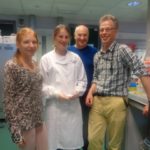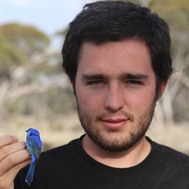Lauren Mee (PhD) @Elle_Gee17
Bees seem to lack many immune genes found in model species which may be because they have evolved social adaptations that help protect them from infection. Alternatively, we might not be finding all of the relevant immune genes because we are only ever looking for genes that are important for immunity in model species. Lauren is using a transcriptomic approach to understand how various hymenopterans (the group that includes bees, wasps, and ants) respond to bacterial infection.
Vicki Orr (MRes) @VickiOrr13
 After completing a degree in Microbiology and Zoology, I discovered that my research interests lie between these disciplines, including the interactions between microbes and hosts in the form of symbiosis and disease. My MRes project involves the effect of pathogen dosage on the degree and duration of immune priming in Bombus terrestris.
After completing a degree in Microbiology and Zoology, I discovered that my research interests lie between these disciplines, including the interactions between microbes and hosts in the form of symbiosis and disease. My MRes project involves the effect of pathogen dosage on the degree and duration of immune priming in Bombus terrestris.
Hazel Farthing (Undergrad)
 My main interests are in ecology and evolution and my project is on exploring novel routes of immune priming (a form of immune memory in invertebrates) in the bumblebee Bombus terrestris.
My main interests are in ecology and evolution and my project is on exploring novel routes of immune priming (a form of immune memory in invertebrates) in the bumblebee Bombus terrestris.
Ayesha Mahmood (Undergrad)

Ayesha is working on understanding some of the mechanisms behind immune memory in bumblebees. She’s generally interested in the immune system and pharmacology i.e. How drugs affect the body, TaeKwonDo and Boxing.
Alicia Showering (Undergrad) 
My main interests are microbiology and infectious disease, this year I am studying a range of modules which include microbial diversity and vector biology. My honours project is to establish RNA interference to knock down genes involved in bumblebees (Bombus terrestris) defense againstthe trypanosome parasite (Crithidia bombi).
Alumni
East Carolina University
Richard (Starling) Krentz Studied honeybee immune memory and adaptive evolution for his M.Sc. Starling now has an industry position researching honeybee health.
Fazillah Faiz, Robert Jennette, Luxurie Mills, and Varen Moore all worked on various undergraduate projects in my lab in 2014-2015.
ETH Zürich
Mathilde Cathebras worked with me on her internship project. Mathilde will be exploring how colony demography influences disease transmission in Bombus terrestris colonies.
Chantal Weibel worked on a semester project that aims to understand how Bombus terrestris respond to exposure to their natural gut community.
Pascal Züger recently finished his bachelor’s semester project working on the population genetics and microbial associations of North American and European populations of grape phylloxera. He then returned to work on a masters project to study the population genetics of North American and European bumblebees.
Franziska Brunner worked with me on a semester project exploring how the bumblebee Bombus terrestris responds to infection with a common trypanosome parasite Crithidia bombi. She liked it so much that she decided to return to do her masters project. Franziska’s new work explores how gene expression changes with exposure to this parasite and will attempt to understand the variation in responses that are seen in the lab and field. She sadly decided to move on and is now a PhD student in Kiel.
Robert Dünner is working on a project with me and Gabriel Leventhal to explore the costs of fecundity compensation. Many organisms respond to cues of risk by increasing reproduction. Robert is using models to predict the conditions under which we might expect fecundity compensation and has also followed up these predictions with experiments.
Eric Seiger recently finished a semester project exploring the influence of mating on immunity in B. terrestris. Mating in many cases initiates a strong physiological response which can be costly and divert resources away from other costly endeavors, like fighting infection.
Emory University
Ben Parker and I have been working on a project to assess the costs of  immunity in pea aphids. Developing, maintaining and using an immune system is takes lots of resources that could go into other important things like reproduction or growth. So immunity must be traded off against other traits. We’re looking at whether we can detect costs in aphid fitness when aphids are given a variety of different pathogens. We also worked together on a review of less commonly discussed mechanisms of immunity.
immunity in pea aphids. Developing, maintaining and using an immune system is takes lots of resources that could go into other important things like reproduction or growth. So immunity must be traded off against other traits. We’re looking at whether we can detect costs in aphid fitness when aphids are given a variety of different pathogens. We also worked together on a review of less commonly discussed mechanisms of immunity.
Jill Spragg* has been exploring the relationship between host genotypic variation in disease susceptibility and protection against a fungal pathogen  conferred by bacterial symbionts. She has been focussing on the interaction between pea aphids, beneficial bacteria that protect them against pathogens, and aphid-specific fungal pathogens. We predict that at least some aphid clones will be less susceptible to fungal infection when carrying the symbiont Regiella insecticola, but the difference in resistance conferred between host genotypes should reflect the complexity of symbiont-host interactions. We are interested to see whether differences in resistance are due to intrinsic susceptibilities in particular aphid clones, the strain of symbiont the aphid carries, or some interaction between particular hosts and symbionts. Jill also examined the expression of antimicrobial peptides in pea aphids in response to fungal infection.
conferred by bacterial symbionts. She has been focussing on the interaction between pea aphids, beneficial bacteria that protect them against pathogens, and aphid-specific fungal pathogens. We predict that at least some aphid clones will be less susceptible to fungal infection when carrying the symbiont Regiella insecticola, but the difference in resistance conferred between host genotypes should reflect the complexity of symbiont-host interactions. We are interested to see whether differences in resistance are due to intrinsic susceptibilities in particular aphid clones, the strain of symbiont the aphid carries, or some interaction between particular hosts and symbionts. Jill also examined the expression of antimicrobial peptides in pea aphids in response to fungal infection.
*Jill is now a grad student at the University of Washington.
Dan Sok worked with me in a series of experiments that looked into how pea
aphids respond to a number of challenges. We found that giving pea aphids
cues of death or stress determines their investment in reproduction. The results of this work can be found in our paper (which is available on the papers page).
